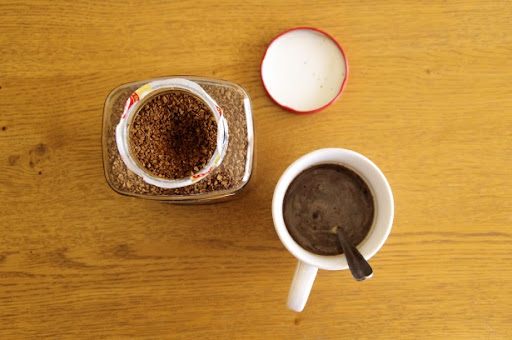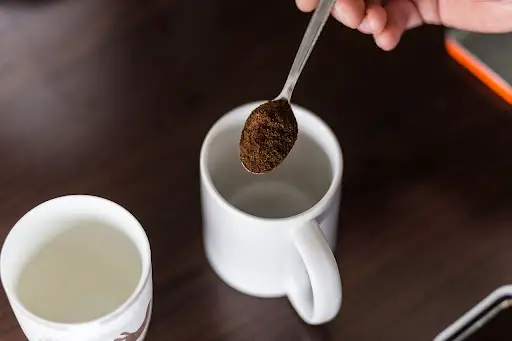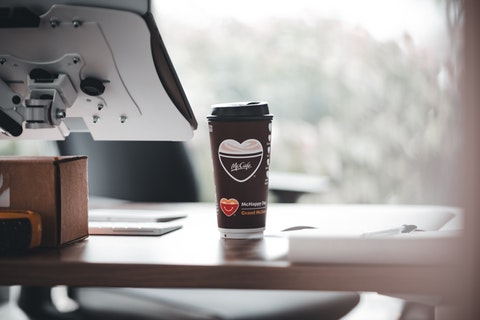As an Amazon Associate I earn from qualifying purchases. When you use our links, we may earn an affiliate commission. Learn more.
Most coffee enthusiasts might not agree on the flavor profile or the aroma of instant coffee. But even if it tastes relatively bland, you can’t deny the convenience and affordability factor it offers.
In recent years instant coffee sales have skyrocketed, with various new flavors and blends introduced.
With ease and convenience comes a series of questions. Does instant coffee have the same effect as a freshly brewed drink? Or is instant coffee powder real coffee? You may also wonder if one cup is enough to beat the Monday blues?

So before we understand the caffeine content in instant coffee, it’s only fair to look at what it is and how it’s made.
How is Instant Coffee Made?
Behind the scenes of your favorite instant coffee brand are pretty similar to how you’d prepare the beans from scratch, except everything is on an industrial scale. The most common methods used for preparation include freeze-drying or spray drying.
First, the whole coffee beans are delivered to the factory in minty green condition. Then, after running through a sieve to remove any debris, they enter the roasting process. Nescafe typically gives the grains a medium roast, ideal for creating a mellow taste.
Bring On The Industrial Grinder
Once the grains have been roasted, they’re cooled and poured into an industrial grinder. Here, the machine breaks down the grains into the coarse ground and traps much of the aroma that would otherwise be lost.
The ground coffee is finally brewed using a method similar to a French press, where hot water is used to extract the caffeine, and the ground is later filtered.
The Final Step
The brewed coffee is left to evaporate until about half of the quantity has been reduced. After the remaining concentrated coffee is chilled, it is broken into flaky granules or fine powder, depending on the type.
Before packaging, it’s ensured that any moisture in the granules is removed through sublimation. Most brands also re-add the lost aroma to increase the richness of instant coffee.
Is Instant Coffee The Real Deal?
There is no doubt that instant coffee sparks controversy amongst coffee drinkers. But is the muted palate or faint aroma the only reason it’s looked down upon, or are there factors in play?
Cheap and Convenient
Instant coffee is far more affordable and convenient than regular coffee. But it’s far from the real deal regarding the overall quality and mouthfeel.
Where ground coffee is actual coffee beans that have been roasted and ground, instant coffee is filtered coffee that has been dehydrated.
Therefore, it instantly dissolves when you stir the instant coffee with boiling water or milk. As for regular coffee, it never wholly dissolves but instead settles at the bottom.
Not For
This difference in mixture creates a varied mouthfeel, so most people find instant coffees to have a bland taste.
As for the caffeine levels, with instant coffee granules, you’re stuck with a certain caffeine percentage that the brand decides. In contrast, if you were to prepare regular coffee, you could easily obtain a higher caffeine content by brewing for longer.
If you need high caffeine content, add more of the instant coffee or wait longer for the ground coffee to brew.
This free cheat sheet will improve your coffee brew by providing quick information on brew ratio, grind size, optimal brewing time, and more.
What are the caffeine levels in Nescafe instant coffee?
Instant coffee has grown highly popular in the last few years due to its convenience. With the Nescafe 3-in-1 packet, you don’t need to worry about adding sugar or creamer to your coffee. Instead, you need to simply pour the mixture into hot water, and you’re good to go.
However, the Nescafe instant coffee is not simply a comforting drink but one that provides a decent caffeine content. It uses a blend of Robusta and Arabica beans.

The 3-in-1 Nescafé packet offers up to 8.33 mg of caffeine per fl oz. So for a standard 6 fl oz cup, you’d get around 50 mg of caffeine.
As for the Nescafé gold, one teaspoon has about 44 mg of caffeine. And with each standard cup requiring 1.5 spoons, you’d get 66 mg of caffeine.
To get an idea about how close instant coffee is to regular coffee, it’s important to note that a single shot of espresso has 64 mg of caffeine. And while different coffee grains offer other caffeine content, one thing is sure – Nescafe instant coffee gets the job done!
How does instant coffee compare in the health department?
It would be inaccurate to introduce instant coffee as a lesser version of ground coffee when it offers many health benefits at a much lower rate.
Because of its lower caffeine content, Instant coffee is ideal for anyone watching their caffeine intake. If you’ve ever been advised to stop drinking coffee or reduce your caffeine consumption, this is your saving grace.
But that’s not all.
It also results in an enhanced nervous system, faster metabolism, and reduced risk of diabetes, liver cancer, and certain neurodegenerative diseases.
It also rids your body of the side effects of using coffee products, such as increased heart rate, profuse sweating, and acid reflux.
However, one thing that may put instant coffee in a terrible light is that it packs many calories, so read the fine print if you’re on a strict diet.
FAQs About Caffeine in Nescafe Instant Coffee
How much caffeine is in Nescafe instant coffee?
The Nescafe classic and Nescafe gold instant coffees contain 50 mg to 90 mg per 2g serving. Similarly, its 3-in-1 sachets offer 28 mg of caffeine per 100 ml.
How much caffeine is in a teaspoon of Nescafe instant coffee?
A medium roast blend, Nescafe gold has about 60-80 mg of caffeine per teaspoon. Using the instant mix, you’d require 1.5 teaspoons for a standard cup. Therefore, each cup offers an average of 105 mg of caffeine.
Does instant coffee have less caffeine?
While there’s no drastic difference, instant coffee contains slightly less caffeine than finely ground coffee. For each teaspoon of instant coffee, there’s 30-90 mg of caffeine. As for a teaspoon of regular coffee, there’s 70-140 mg of caffeine.
Which instant coffee has the most caffeine?
With multiple instant coffees in the market, The Death Wish instant coffee currently tops the list with 485 mg of caffeine per 8 fl oz. On the second number is the Starbucks VIA instant coffee, which contains 135 mg per 8 fl oz.
This free cheat sheet will improve your coffee brew by providing quick information on brew ratio, grind size, optimal brewing time, and more.


